Bukit Brown : Documenting New Horizons of Knowledge
0
Bukit Brown : Documenting New Horizons of Knowledge
Location: NLB 9th floor from now until 10 October’14 and thereafter it will travel to other regional libraries.
The exhibition was officially opened on Saturday 19 July,2014 by MOS (Ministry of National Development) Desmond Lee.
It represents almost one and half years of research and working the ground documenting some 4,153 tombstones which are affected by the building of a new highway across Bukit Brown, by a team under the leadership of Dr. Hui Yew-Foong, an anthropologist with ISEAS.
We have observed the team hard at work over these years, joined some of them during Qing Ming and exhumations as observers and friends of the family of descendants, and the exhibition is a comprehensive and compact expression of what they have uncovered, shared with the public with insight and interesting artefacts , enhanced by new technology. We recommend it as a “must see” and “ground breaking” for insights shared of customary practices and traditions of burial customs and respect for ancestors.
An extract from the media release:
Documenting New Horizons of Knowledge” assembles a diverse range of documents,maps, photographs and objects to demonstrate how a cemetery can open a window to Singapore’s historical past and cultural present. Through a multi-disciplinary approach employing cutting-edge methods, techniques and technology, the exhibition will bring to the fore new horizons of knowledge unveiled through the documentation of Bukit Brown.
The exhibition opens with the origins of the cemetery, as a project of the Municipal Commissioners in early 20th in 1973, will be illustrated through maps and aerial photographs. Next, through explication of tomb inscriptions, tomb typology and the material culture of the cemetery, the exhibition will demonstrate Singapore’s connectivity to the region, China and the world.
While the cemetery is a burial space for the dead, it is also a space for the living at different points of Singapore’s history and ritual calendar. This will be illustrated through the life of kampongs that used to be situated in the vicinity of the cemetery and the life of the cemetery during Qing Ming and the Seventh Month Hungry Ghost Festival.
As data for the graves was collected and organised within a Geographic Information System (GIS) framework, the exhibition will present a Centrepiece where visitors will be able to access data related to specific graves through a map-based database on a touch screen monitor.
Finally, visitors will get a glimpse behind the scenes of documentation work, to get a sense of the different methods, techniques and technologies that were employed in the course of documentation. These range from balloon photography to 3D scanning, from interviewing to filming, and from the work of architects to the work of archaeologists.
****
Highlights of the Exhibition Opening
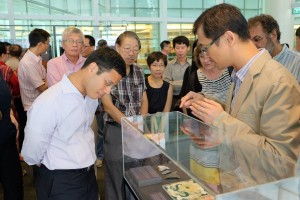
Dr Hui Yew-Foong, explaining material culture to MOS Desmond Lee during the curator’s walk through (photo Ang Hock Chuan)
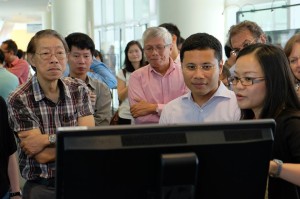
Dr. Natalie Pang (NTU) who worked on the IT applications for the centerpiece map demonstrating how it works to MOS Desmond Lee (photo Ang Hock Chuan)
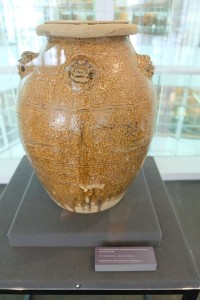
The urn which used to house re-interred remains from other cemeteries to Bukit Brown (photo Raymond Goh)
This urn was used to re-inter bones exhumed from an older cemetery. It was from the grave of Madam Khoo Siok Hui, who died in 1836. Her grave was the oldest among those documented at Bukit Brown. Madam Khoo and her son Chee Yam Chuan were among the early settlers of Singapore. Mr Chee later returned to Malacca and made his fortune in tin mining in Selangor. Today, the Chee Yam Chuan Temple Trust continues to flourish in Malacca and Madam Khoo’s ancestral tablet can be found in the temple. The story behind this family shows the close links between Malacca and Singapore in the early years. It was Raymond Goh who first deciphered the inscription and unraveled the connection.
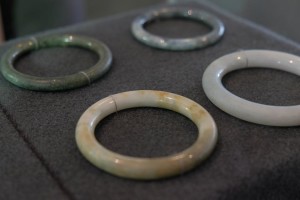
Treasure trove of jade bracelets worn by the women and traditionally buried with their wearers. (photo Ang Hock Chuan)
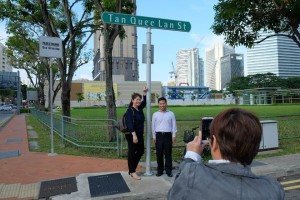
Descendant Serene Tan of pioneer Tan Quee Lan, gets one for the album when MOS Desmond Lee sportingly agrees to walk with her to visit her “great great grandfather’s road” ( photo Ang Hock Chuan)
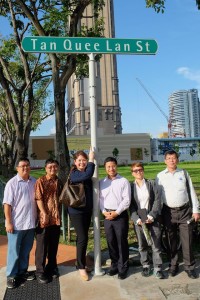
They were accompanied by a entourage of brownies who have been sharing Serene’s journey of reconnecting with her ancestors since Raymond Goh found the Tan Quee Lan cluster re-interred from another cemetery at Bukit Brown (photo Ang Hock Chuan)
A video at the exhibition features Serene Tan and her family observing the first Qing Ming at Bukit Brown in 2012 after Raymond Goh discovered the cluster of Tan Quee Lan tombs, and shows how the cluster underwent a renovation makeover by Serene and her cousin LT Tan who met at Bukit Brown itself. Serene’s story can be read here
The cluster is not affected by highway.
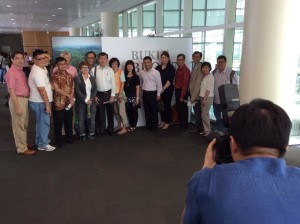
Brownies, academics, descendants, members of the documentation team at the exhibition (photo Khoo Ee Hoon)
“….to everyone who came and supported the launch, and most importantly, supported us and helped us generously with our research over the last 33 months. One of the purposes of the exhibition is to acknowledge all your contributions and I hope it accomplished that.” Dr Hui Yew- Foong, Curator of Exhibition on a FB posting.
Look out for 2 specially curated walks by the Brownies in conjunction with the exhibition in August (English) and September (Mandarin).
Photos taken of the exhibition courtesy of Brownie Ang Hock Chuan on Facebook here
Read more about the exhibition by the Rojak Librarian here

Comments